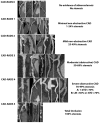Photon-Counting Computed Tomography in Atherosclerotic Plaque Characterization
- PMID: 38893593
- PMCID: PMC11172199
- DOI: 10.3390/diagnostics14111065
Photon-Counting Computed Tomography in Atherosclerotic Plaque Characterization
Abstract
Atherosclerotic plaque buildup in the coronary and carotid arteries is pivotal in the onset of acute myocardial infarctions or cerebrovascular events, leading to heightened levels of illness and death. Atherosclerosis is a complex and multistep disease, beginning with the deposition of low-density lipoproteins in the arterial intima and culminating in plaque rupture. Modern technology favors non-invasive imaging techniques to assess atherosclerotic plaque and offer insights beyond mere artery stenosis. Among these, computed tomography stands out for its widespread clinical adoption and is prized for its speed and accessibility. Nonetheless, some limitations persist. The introduction of photon-counting computed tomography (PCCT), with its multi-energy capabilities, enhanced spatial resolution, and superior soft tissue contrast with minimal electronic noise, brings significant advantages to carotid and coronary artery imaging, enabling a more comprehensive examination of atherosclerotic plaque composition. This narrative review aims to provide a comprehensive overview of the main concepts related to PCCT. Additionally, we aim to explore the existing literature on the clinical application of PCCT in assessing atherosclerotic plaque. Finally, we will examine the advantages and limitations of this recently introduced technology.
Keywords: atherosclerosis; carotid; coronary; photon-counting detector; plaque vulnerability.
Conflict of interest statement
Jasjit S. Suri was employed by the company AtheroPointTM. The remaining authors declare no conflicts of interest.
Figures








References
-
- Dai H., Much A.A., Maor E., Asher E., Younis A., Xu Y., Lu Y., Liu X., Shu J., Bragazzi N.L. Global, regional, and national burden of ischaemic heart disease and its attributable risk factors, 1990-2017: Results from the Global Burden of Disease Study 2017. Eur. Heart J.-Qual. Care Clin. Outcomes. 2022;8:50–60. doi: 10.1093/ehjqcco/qcaa076. - DOI - PMC - PubMed
Publication types
LinkOut - more resources
Full Text Sources

